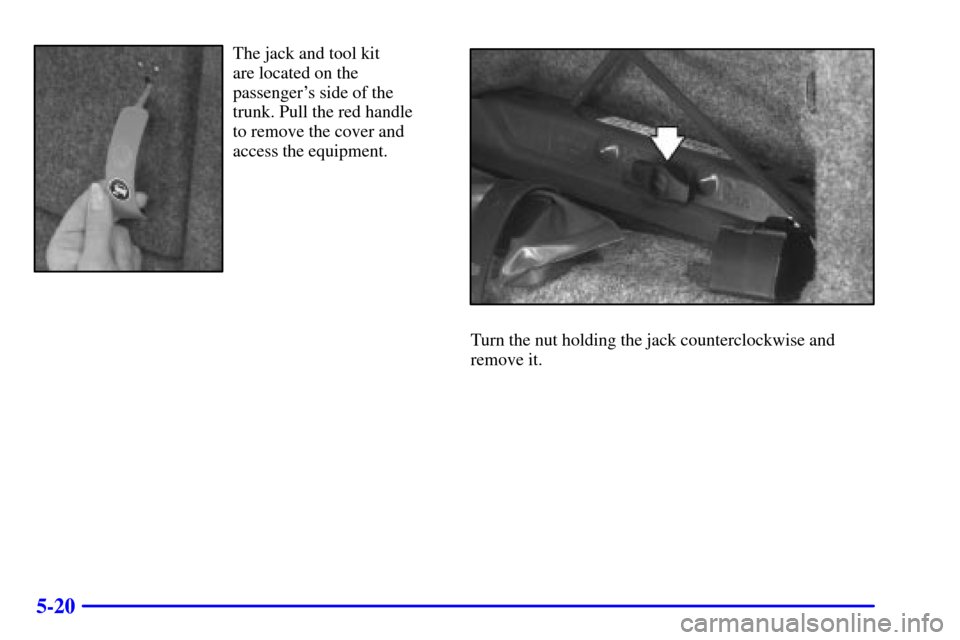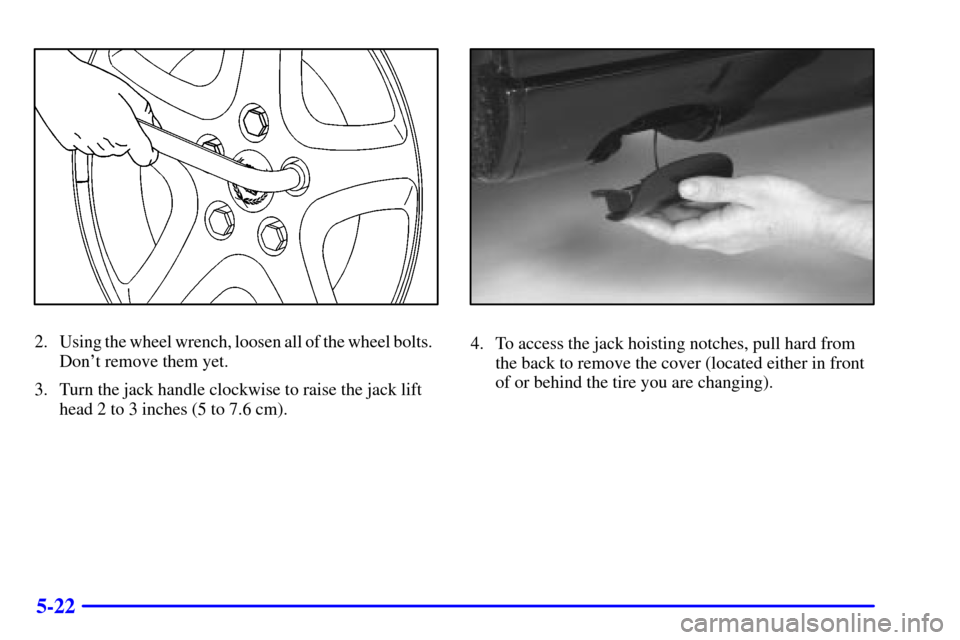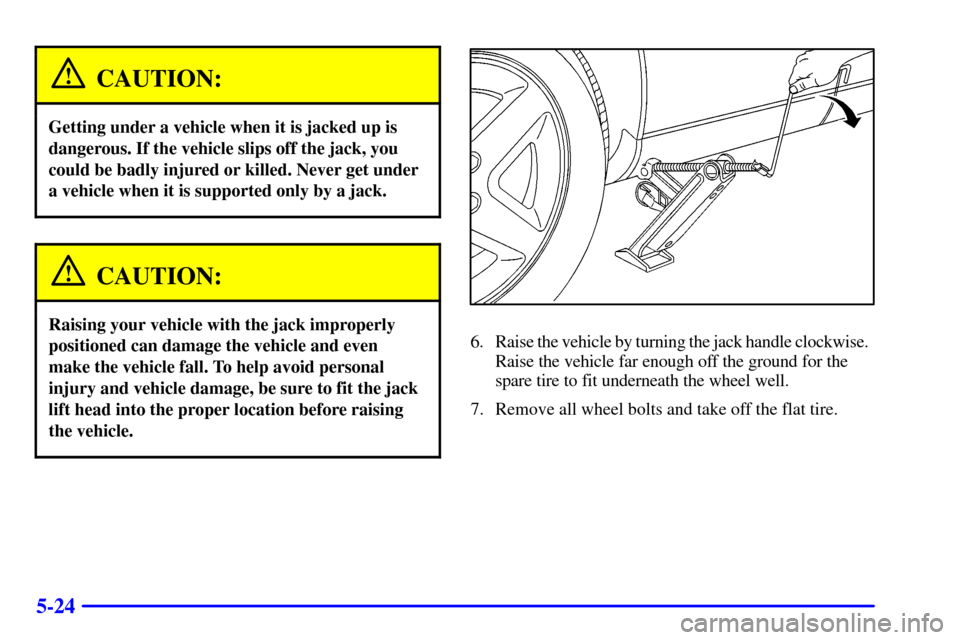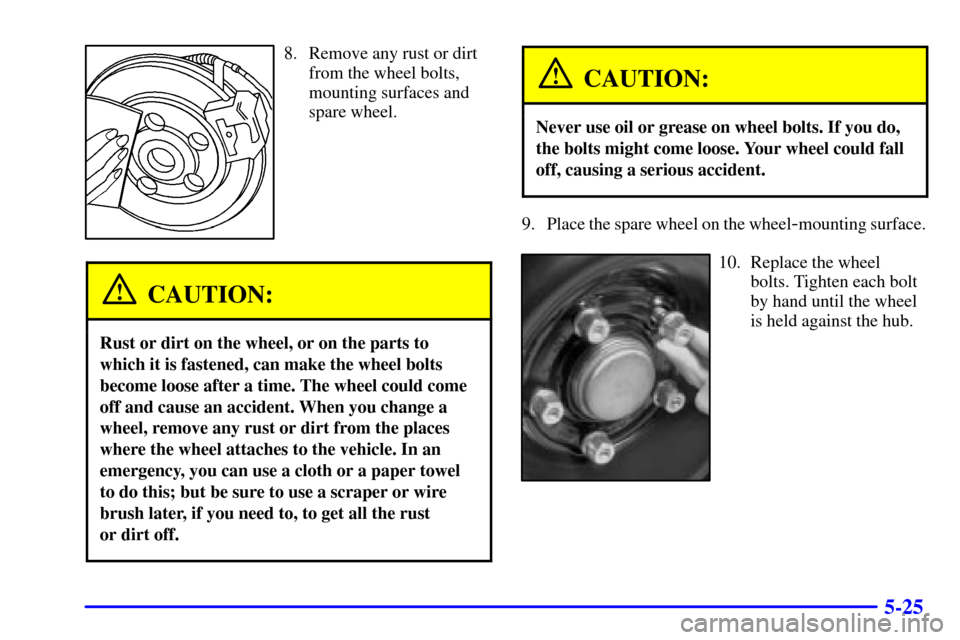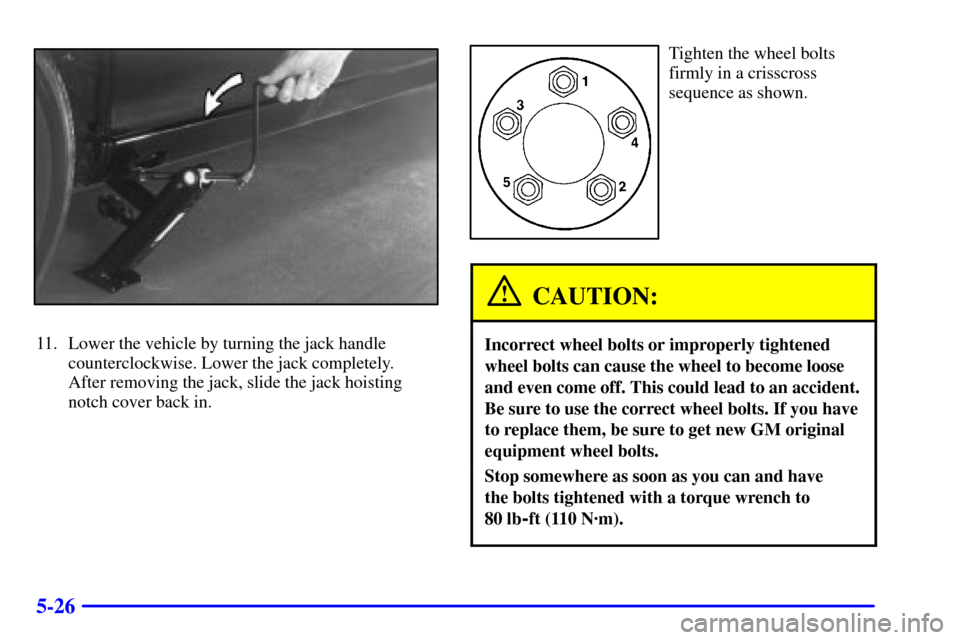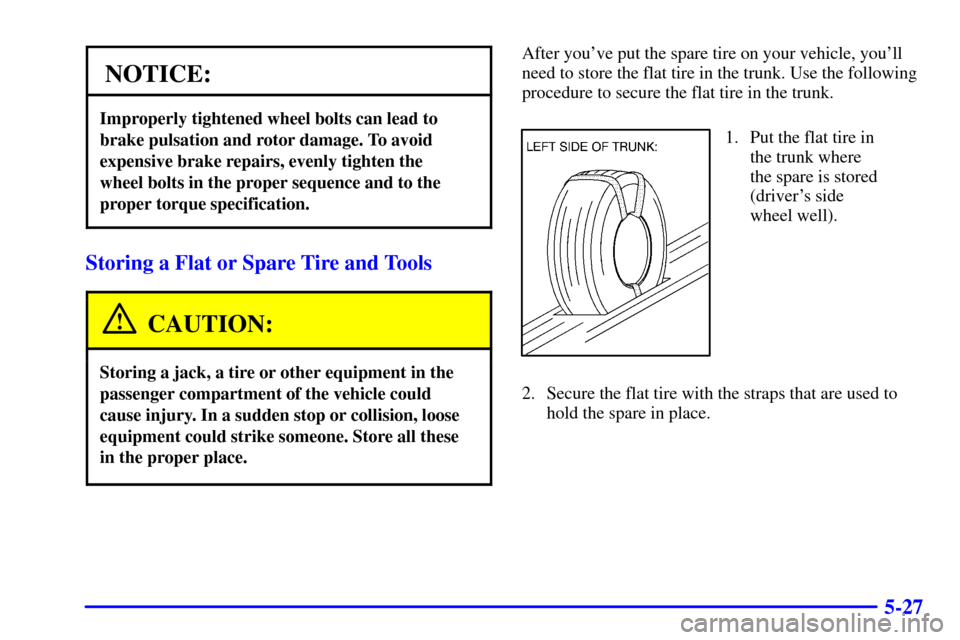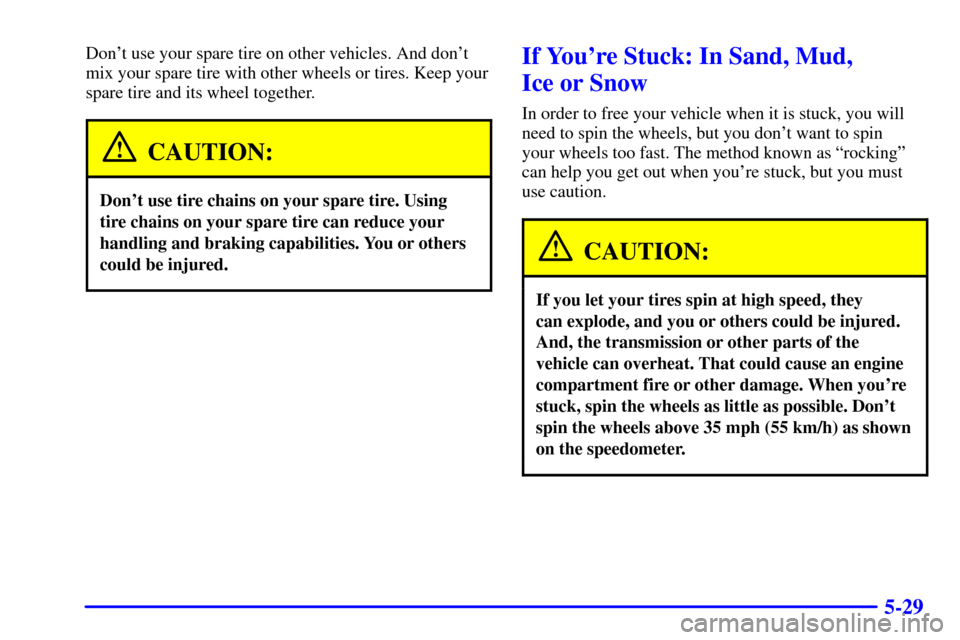CADILLAC CATERA 2001 1.G Owners Manual
CATERA 2001 1.G
CADILLAC
CADILLAC
https://www.carmanualsonline.info/img/23/7855/w960_7855-0.png
CADILLAC CATERA 2001 1.G Owners Manual
Trending: alarm, tire pressure, engine, sport mode, weight, CD changer, wheel alignment
Page 241 of 328
5-20
The jack and tool kit
are located on the
passenger's side of the
trunk. Pull the red handle
to remove the cover and
access the equipment.
Turn the nut holding the jack counterclockwise and
remove it.
Page 242 of 328
5-21
The tools you'll be using include the jack (A), the wheel
wrench (B) and the screwdriver (C).
Removing the Flat Tire and Installing
the Spare Tire
1. Use the flat end of the screwdriver to pry off the
five black plastic wheel bolt caps. Be careful not to
scratch the wheel edge.
Page 243 of 328
5-22
2. Using the wheel wrench, loosen all of the wheel bolts.
Don't remove them yet.
3. Turn the jack handle clockwise to raise the jack lift
head 2 to 3 inches (5 to 7.6 cm).4. To access the jack hoisting notches, pull hard from
the back to remove the cover (located either in front
of or behind the tire you are changing).
Page 244 of 328
5-23
5. Position the jack under the vehicle.The base of the jack must line up vertically with the
hoisting notch (jack contact point) on the vehicle's
frame, nearest the flat tire. Make sure that the base
is flat against the ground in order to have enough
clearance to turn the jack handle. Then, raise the jack
lift head until it is firmly set into the hoisting notch.
Page 245 of 328
5-24
CAUTION:
Getting under a vehicle when it is jacked up is
dangerous. If the vehicle slips off the jack, you
could be badly injured or killed. Never get under
a vehicle when it is supported only by a jack.
CAUTION:
Raising your vehicle with the jack improperly
positioned can damage the vehicle and even
make the vehicle fall. To help avoid personal
injury and vehicle damage, be sure to fit the jack
lift head into the proper location before raising
the vehicle.6. Raise the vehicle by turning the jack handle clockwise.
Raise the vehicle far enough off the ground for the
spare tire to fit underneath the wheel well.
7. Remove all wheel bolts and take off the flat tire.
Page 246 of 328
5-25
8. Remove any rust or dirt
from the wheel bolts,
mounting surfaces and
spare wheel.
CAUTION:
Rust or dirt on the wheel, or on the parts to
which it is fastened, can make the wheel bolts
become loose after a time. The wheel could come
off and cause an accident. When you change a
wheel, remove any rust or dirt from the places
where the wheel attaches to the vehicle. In an
emergency, you can use a cloth or a paper towel
to do this; but be sure to use a scraper or wire
brush later, if you need to, to get all the rust
or dirt off.
CAUTION:
Never use oil or grease on wheel bolts. If you do,
the bolts might come loose. Your wheel could fall
off, causing a serious accident.
9. Place the spare wheel on the wheel-mounting surface.
10. Replace the wheel
bolts. Tighten each bolt
by hand until the wheel
is held against the hub.
Page 247 of 328
5-26
11. Lower the vehicle by turning the jack handle
counterclockwise. Lower the jack completely.
After removing the jack, slide the jack hoisting
notch cover back in.
Tighten the wheel bolts
firmly in a crisscross
sequence as shown.
CAUTION:
Incorrect wheel bolts or improperly tightened
wheel bolts can cause the wheel to become loose
and even come off. This could lead to an accident.
Be sure to use the correct wheel bolts. If you have
to replace them, be sure to get new GM original
equipment wheel bolts.
Stop somewhere as soon as you can and have
the bolts tightened with a torque wrench to
80 lb
-ft (110 N´m).
Page 248 of 328
5-27
NOTICE:
Improperly tightened wheel bolts can lead to
brake pulsation and rotor damage. To avoid
expensive brake repairs, evenly tighten the
wheel bolts in the proper sequence and to the
proper torque specification.
Storing a Flat or Spare Tire and Tools
CAUTION:
Storing a jack, a tire or other equipment in the
passenger compartment of the vehicle could
cause injury. In a sudden stop or collision, loose
equipment could strike someone. Store all these
in the proper place.
After you've put the spare tire on your vehicle, you'll
need to store the flat tire in the trunk. Use the following
procedure to secure the flat tire in the trunk.
1. Put the flat tire in
the trunk where
the spare is stored
(driver's side
wheel well).
2. Secure the flat tire with the straps that are used to
hold the spare in place.
Page 249 of 328
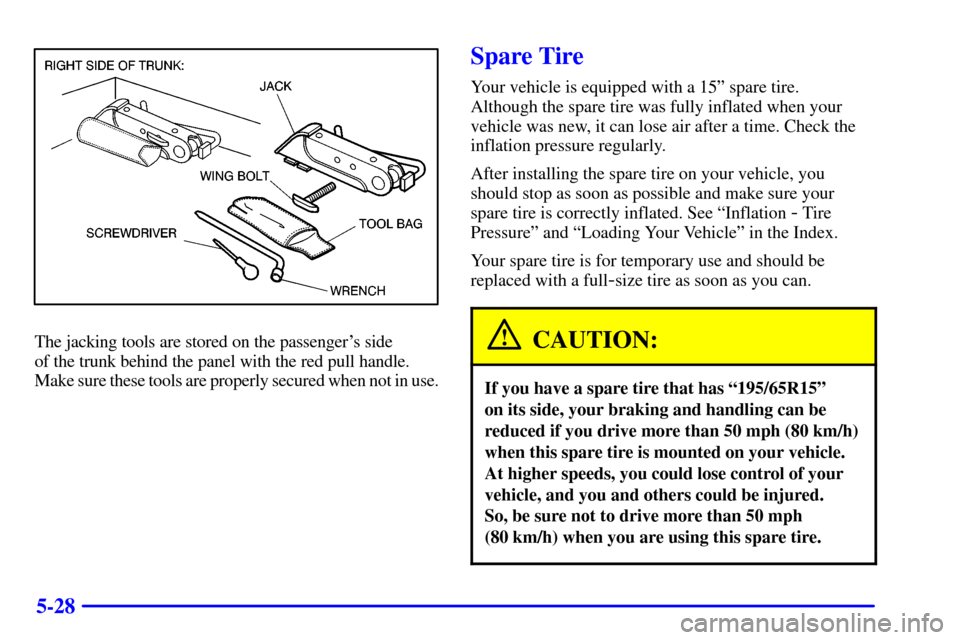
5-28
The jacking tools are stored on the passenger's side
of the trunk behind the panel with the red pull handle.
Make sure these tools are properly secured when not in use.
Spare Tire
Your vehicle is equipped with a 15º spare tire.
Although the spare tire was fully inflated when your
vehicle was new, it can lose air after a time. Check the
inflation pressure regularly.
After installing the spare tire on your vehicle, you
should stop as soon as possible and make sure your
spare tire is correctly inflated. See ªInflation
- Tire
Pressureº and ªLoading Your Vehicleº in the Index.
Your spare tire is for temporary use and should be
replaced with a full
-size tire as soon as you can.
CAUTION:
If you have a spare tire that has ª195/65R15º
on its side, your braking and handling can be
reduced if you drive more than 50 mph (80 km/h)
when this spare tire is mounted on your vehicle.
At higher speeds, you could lose control of your
vehicle, and you and others could be injured.
So, be sure not to drive more than 50 mph
(80 km/h) when you are using this spare tire.
Page 250 of 328
5-29
Don't use your spare tire on other vehicles. And don't
mix your spare tire with other wheels or tires. Keep your
spare tire and its wheel together.
CAUTION:
Don't use tire chains on your spare tire. Using
tire chains on your spare tire can reduce your
handling and braking capabilities. You or others
could be injured.
If You're Stuck: In Sand, Mud,
Ice or Snow
In order to free your vehicle when it is stuck, you will
need to spin the wheels, but you don't want to spin
your wheels too fast. The method known as ªrockingº
can help you get out when you're stuck, but you must
use caution.
CAUTION:
If you let your tires spin at high speed, they
can explode, and you or others could be injured.
And, the transmission or other parts of the
vehicle can overheat. That could cause an engine
compartment fire or other damage. When you're
stuck, spin the wheels as little as possible. Don't
spin the wheels above 35 mph (55 km/h) as shown
on the speedometer.
Trending: fuel filter, service, boot, stop start, coolant level, air conditioning, jacking
